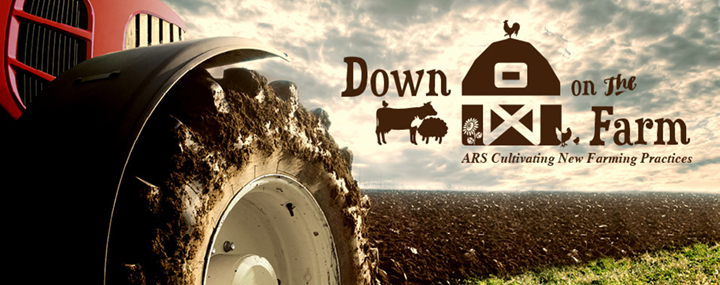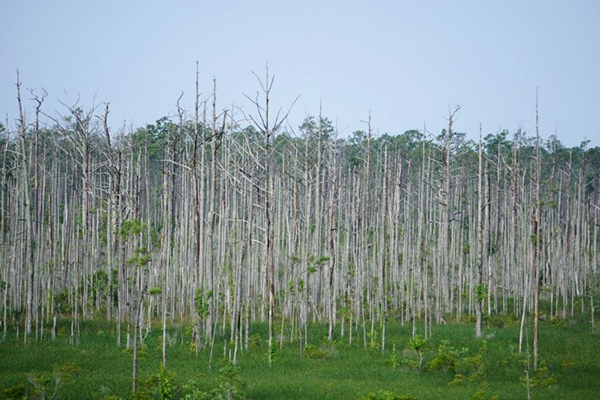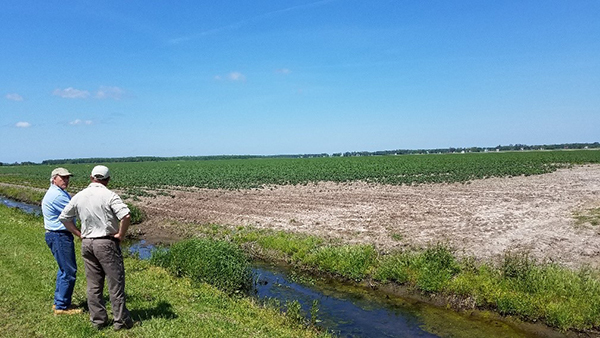
Helping Southeast U.S. Coastal Producers Identify, Mitigate, and Adapt to Increasing Soil Salinization
Droughts and heatwaves, floods, wildfires, and hurricanes can cause billions of dollars in damage to agriculture and forestry. As a result of these events, saltwater intrusion into the forest, agriculture, and pastureland soils across eastern Coastal and the Gulf States can negatively impact productivity and profitability. Saltwater intrusion's negative impacts include tree and crop death, reduced growth, and lower crop yields. Even though biological productivity may still be possible, the economic value in maintaining these working lands can be insufficient to justify continued use.
Mitigation measures, including leaching with freshwater and installing water control structures to sustain land productivity at risk of salinization, can be used when they are economically beneficial. However, these measures can be costly and unproductive without proper guidance.
Adaptation measures can also be applied in preparation for potential inputs of saltwater. Chronic saltwater inputs will inevitably require landowners to implement adaptation measures, including planting more salt-tolerant crops to continue gaining profit from land cultivation.
 Ghost Forest in Eastern North Carolina. Photo courtesy of NCwetlands.org
Ghost Forest in Eastern North Carolina. Photo courtesy of NCwetlands.org
Agriculture landowners seeking guidance on salinization mitigation or adaption measures have a new resource at their fingertips: Identification, Mitigation, and Adaptation to Salinization on Working Lands in the U.S. Southeast. This guide, developed by the Southeast Climate Hub in collaboration with USDA’s Agricultural Research Service and Natural Resources Conservation Service, can assist producers, as well as extension agents, landowners, field staff, and private consultants, in determining their land's stage of soil salinization.
“This is a general guide for the U.S. Southeast, and specific recommendations will depend on the producer's site conditions,” said Steven McNulty, Southeast Climate Hub director and guide co-author. “The guide also provides information regarding expected production reductions for economically important crop species and cultivars across various soil salinity levels.”
McNulty noted that the guide does not predict the rates of sea-level rise or soil salinization; rather, it provides mitigation and adaptation practices that can reduce soil salinization impacts on productivity. The guide divides salinization levels into stages to allow the producer to assess the soil's condition and management options more easily.
 Agricultural soil salinization in Eastern North Carolina. Photo courtesy of Michael Gavazzi
Agricultural soil salinization in Eastern North Carolina. Photo courtesy of Michael Gavazzi
“At some point, the land may no longer be commercially profitable,” McNulty said. “The guide includes a chapter that helps determine when farming or forestry is no longer advisable and when the land could be better used as a conservation easement.“
While the recommendations and information provided in the guide are valuable for producers, they should still consult with their county extension specialist, soil conservation district office, or other professional service providers to assist in extending the productive life of salt-impacted soils, McNulty said.
“Producers cannot control hurricanes or sea-level rise, but they can use adaptive management to maximize profits from these impacted lands despite these increasing challenges,” McNulty said.— By Emile Elias, Research Hydrologist, USDA Southwest Climate Hub.
References Cited: Gedan, K. B., Epanchin-Niell, R., & Qi, M. (2020). Rapid Land Cover Change in a Submerging Coastal County. Wetlands, (2017). https://doi.org/10.1007/s13157-020-01328-y
